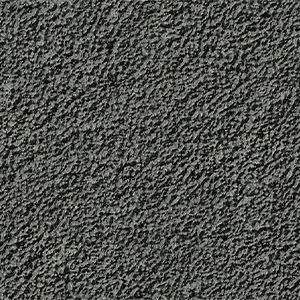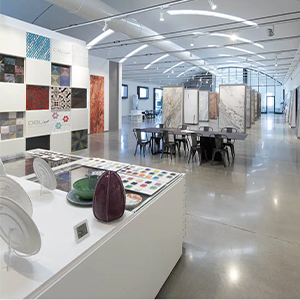Index
- Introduction
- What is R10 non-slip flooring
- Materials available for the R10 non-slip floor
- Ideal applications
- Advantages of the R10 floor
- How to choose the right non-slip floor
- Maintenance and durability
- Conclusions
- FAQ
Introduction
Safety in flooring is a key issue, especially in environments where moisture or the presence of liquids can increase the risk of slipping.
In this context, choosing an R10 non-slip floor means adopting a balanced solution between safety, aesthetics and maintenance.
The anti-slip R classification-ranging from R9 (low grip) to R13 (maximum grip)-makes it easy to identify the level of grip best suited to each environment. The R10 level is a versatile solution, ideal for indoor spaces and semi-outdoor areas with moderate exposure to moisture.
What is R10 anti-slip floor
The anti-slip R classification is based on European standards (DIN 51130 and EN 16165) and is defined through tests on inclined surfaces, which simulate real walking conditions in wet environments.
R10 represents an intermediate category, with a dynamic friction coefficient between 0.30 and 0.35, providing a good balance between safety and comfort of use.
This classification is critical for identifying safe floors in settings where the risk of slipping is present but not high, such as bathrooms, kitchens or entryways.
The R10 level provides effective protection in moderate humidity environments, offering a technical solution suitable for both residential projects and professional settings.
| R-Class | Coefficient of friction | Recommended applications |
| R9 | ≤ 0.30 | Dry environments |
| R10 | 0.30–0.35 | Bathrooms, kitchens, entrances |
| R11 | 0.35–0.40 | Laboratories, industrial kitchens |
| R12-13 | ≥ 0.40 | Industrial environments, ramps, swimming pools |
PLEASE NOTE: R10 is often the best choice for those who want safe floors without sacrificing aesthetics and ease of maintenance.
Materials available for the R10 non-slip floor
R10-rated floors are made of ceramic materials with specific textures and surface treatments. Popular options include:
Non-slip porcelain stoneware
- High mechanical and chemical resistance.
- Available in multiple finishes and colors.
- Excellent for residential and public environments.
Ceramic Glazed
- Surface treated with non-slip glazes.
- Suitable for bathrooms, kitchens and living areas.

Cotto and klinker
- More rustic and porous appearance.
- Suitable for porches and covered terraces.
Sicer provides a range of technical solutions specifically developed to create vitrified surfaces with unique characteristics on ceramic substrates. In particular, the mixture of micro grits in the NEXT EXPERIENCE SURFACES series makes it possible to obtain textured, totally matt and anti-reflective surfaces with a coefficient of friction ranging from R9 to R11. This technology is ideal not only to ensure high safety standards, but also to provide a surface that is pleasant to the touch, also suitable for indoor use, and optimal transparency that enhances color development. NEXT EXPERIENCE SURFACES is also particularly suitable for the production of natural stone-effect ceramic collections, thanks to its natural aesthetic rendering and anti-reflective finish similar to the stone itself. In addition to ensuring high safety standards, this technology also ensures excellent cleanability and resistance to chemicals.
Ideal applications
The versatility of R10 non-slip flooring makes it suitable for a variety of uses, both as indoor non-slip flooring and for semi-outdoor settings:
Residential environments
- Bathrooms: prevention of slipping in the presence of steam or water.
- Kitchens: where the presence of splashes is frequent.
- Living areas with external access: entrances, hallways.
Commercial Environments
- Offices: to ensure safety in corridors and common areas.
- Stores and showrooms: where aesthetics and functionality must coexist.
- Waiting rooms: transit areas with moderate traffic.
Covered outdoor areas
- Covered porches and terraces: exposed but protected from direct rain, ideal as moderate outdoor flooring.
Advantages of R10 non-slip floor

Opting for an R10 non-slip floor means choosing a surface that combines safety, versatility and ease of handling.
This solution is distinguished by a set of advantages that address both functional and aesthetic needs, making it ideal for a wide range of environments, from residential to professional use.
One of the main benefits is safety: thanks to its intermediate coefficient of friction, R10 flooring significantly reduces the risk of slipping in moderately wet environments, such as bathrooms, kitchens, waiting rooms or entrances.
For this reason, it is considered one of the best options among indoor safe floors.
From an aesthetic point of view, R10 surfaces offer remarkable design versatility.
The availability of R10 non-slip tiles in various sizes, textures and finishes makes it possible to seamlessly integrate safety within even very sophisticated architectural projects, without compromising on design.
In addition, compared with rougher surfaces such as those rated R11 or higher, R10 floors are easier to clean and maintain.
This translates into a tangible benefit in terms of non-slip floor maintenance, especially in high-traffic environments.
Finally, the durability of R10-level safe materials should be emphasized: when made with quality technologies, such as those used in Sicer products, they ensure a long service life and consistent performance over time, even in professional settings.
One of the unique features of Sicer’s offerings is the presence of an in-house Technology Lab, a highly specialized team of chemical engineers and laboratory technicians.
This group is engaged in daily research and development of innovative materials for ceramic surfaces, ensuring strength, aesthetics and non-slip performance.
The proposed solutions are tested according to the latest European standards and use state-of-the-art technologies to provide safe, durable and visually impactful surfaces.
How to choose the right non-slip floor
The choice of the most suitable non-slip floor cannot be made without careful evaluation of the context of use and specific needs.
The R10 level, in particular, is designed to combine technical performance and design, and is an effective solution in many situations, both residential and professional.
The main factors to consider undoubtedly include the level of foot traffic expected: for environments frequented daily by people, such as home kitchens, waiting rooms or business entrances, it is essential to opt for safe R10-level materials that provide good slip resistance.
Another deciding factor is exposure to liquids or moisture.
If the space is subject to water splashes or steam (such as in bathrooms), R10 non-slip tiles are particularly suitable because of their balance of grip and ease of cleaning.
Of course, aesthetics also play a key role.
Today, thanks to the evolution of surface treatments, R10-rated ceramics can be found in a wide range of finishes, colors and textures, meeting both functional and design requirements.
This enables the selection of safe floor designs that can enhance environments without sacrificing safety.
For a comprehensive evaluation, it is advisable to contact qualified suppliers and, if necessary, seek technical advice to identify the most suitable solution based on the intended application.
Sicer’s technical team is fully available to provide support in selecting the most suitable materials according to specific application requirements. Our chemical engineers support ceramic laboratories in defining safe, high-performance surfaces that meet the required quality standards.
Maintenance and durability of R10 anti-slip floor
One of the most appreciated features of the R10 non-slip floor is its simplicity in daily handling. The lightly textured surface, typical of this classification, allows for good safety standards without making cleaning complicated.
This is especially relevant for those who need to maintain orderly and efficient environments, such as offices, studios, kitchens or reception areas.
Maintenance of R10-level safe floors requires no special precautions: just use neutral detergents and non-abrasive tools to preserve the non-slip properties over time.
Conversely, the use of waxes, polishes or acid-based products, which could alter surface adhesion, is not recommended.
From the point of view of durability, the ceramic materials used in the production of R10 tiles guarantee a long service life, even under frequent stresses.
Due to their mechanical strength and color stability, these floors maintain their performance even after years of use, helping to reduce the cost of replacement or extraordinary maintenance.
In summary, choosing an R10 floor is not only about improving safety, but also about relying on a solution that is management efficient and sustainable over time.
The durability of ceramic materials, combined with ease of cleaning, is an additional competitive advantage for those working in the design industry or managing professional spaces.Thanks to Sicer‘s technological know-how, R10-rated floors are tested according to EN 16165 with PTV (Pendulum Test Value) values between 40 and 50, ensuring consistent performance over time.
Conclusions
The R10 anti-slip floor is an optimal solution for ensuring safety without sacrificing aesthetics. It is suitable for multiple settings-residential, commercial, and semi-outdoor-and allows for easy management due to its easy maintenance.For those seeking a balance between technical performance and visual elegance, the R10 level is often the most appropriate choice.
FAQ
Indica un livello medio di resistenza allo scivolamento secondo la norma DIN 51130 o EN 16165.
Che il pavimento offre un buon grip anche in condizioni di umidità moderata.
Per la classificazione R10, il coefficiente è generalmente compreso tra 0,30 e 0,35.







